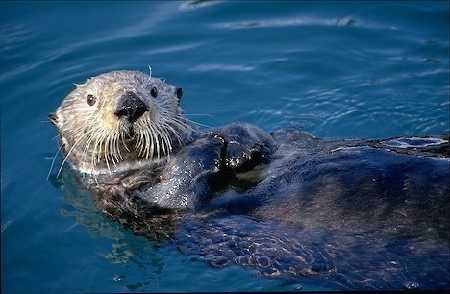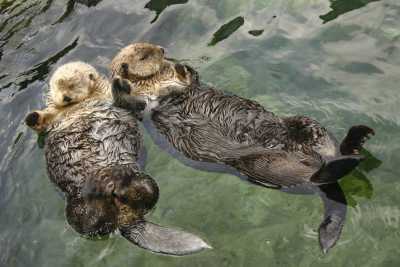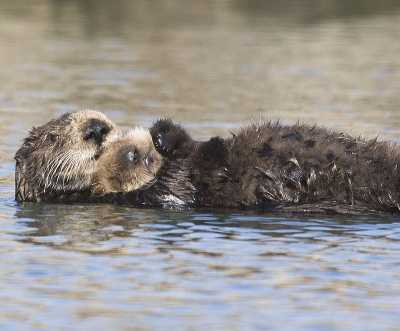 SKC Films Library |
| SKC Films Library >> Science >> Zoology >> Mammals >> Order Carnivora >> Family Mustelidae |
| Sea Otter Enhydra lutris
Description The sea otter has a circular, furry face with a short nose, rounded eyes and ears, and long whiskers. The hind legs are long and the paws are broad, flat and webbed. The forelimbs are short and have retractable claws, which help with grooming and eating. Patches of loose skin under the forearms are used to help store tools (usually a rock) g, and to transport food during diving. Unlike other marine mammals, sea otters do not have blubber. Instead, they must rely on their two-layed fur, which consists of a dark undercoat and longer, lighter-colored guard hairs, which trap a layer of air next to the skin to keep it dry. Overall color is usually brown or reddish-brown. Sea otter fur is the densest of all mammals, with about 100,000 hairs per square centimeter (about a million per square inch); by contrast, humans have about 20,000 hairs on their whole head. The largest otter, males can measure up to 4 feet in length and weigh up to 65 pounds. Distribution and Habitat Three subspecies of E. lutris are recognized today. Enhydra lutris lutris ranges from the Kuril Islands north to the commander islands in the western pacific. Enhydra lutris nereis is found off the coast of central California. Enhydra lutris kenyoni is distributed throughout the Aleutian Islands and southern Alaska, and has been reintroduced to various locations from south of Prince William Sound, Alaska to Oregon. Sea otters inhabit temperate coastal waters with rocky or soft sediment ocean bottom. They live in offshore forests of giant kelp. While capable of diving to depths of at least 145 feet, they prefer coastal waters up to 100 feet deep. Habits and Behaviors Sea otters spend the majority of their time in the ocean, but will rest on land when the population density is high or during stormy weather. Although they generally forage alone, sea otters congregate in single-sex groups known as rafts or pods when resting. Rafts in California rarely exceed 50 individuals, but in Alaska, where the population density is higher, up to 2,000 otters can gather. When resting or sleeping, sea otters float on their back and wrap themselves in kelp to keep from drifting. Their hind limbs stick out of the water and their forelimbs are either folded on their chest or used to cover their eyes. It is also common for two or more otters to hold "hands" while sleeping.
Sea otters utilize vertical undulations of the body to swim, tucking in the forelimbs and using the hind limbs and tail to control their motion. They can swim as fast as 5 miles per hour under water. Foraging dives usually last 50 to 90 seconds, but otters can remain submerged for nearly 6 minutes. Diet Sea otters will eat virtually any fish or marine invertebrates they can find in their kelp forest foraging grounds, with mussels, snails, crabs, and urchins being the most common. Individuals tend to be specialized in their choice of prey -- one otter may consume only urchins and crabs, while another may eat mostly fish, depending on the abilities of the individual and local food availability. Due to their high metabolic rate, sea otters must consume 20 to 25% of their body weight each day. The sea otter has a very effective method for catching food. After taking a huge breath, it leaps into the water. It then swims to the bottom and starts searching for food. When it's underwater, it can use its extremely sensitive whiskers (called vibrassae) to find a small crab or snail hiding in the seaweed or a crevice. It might also use its forepaws to reach into crevices for limpets or chitons that it cannot see. With its surprisingly strong paws, they can easily go through kelp beds in search of crabs or snails. These skills are also of great use when catching one of the sea otters' favorite foods, abalone. In order to force the abalone to "let go" of the rock it is "holding onto," uses a large stone to hammer the side of the shell, often at the rate of 45 blows in 15 seconds. It may take two to three dives for abalone bashing, but the sea otter's persistence eventually pays off. Sea otters are also good clam diggers. Once food is acquired, the sea otter will tuck it into loose skin folds in its armpits, which are used like shopping bags. It will then return to the surface to either eat or just to get a breath and dive again. Sea otters break open prey items with hard shells or exoskeletons with a rock. Some hold the rock on their chest and drive the prey into the rocks, while others leave the prey on their chests and hit the prey with the rocks. The same rock is kept for many dives. Otters often wash their prey by holding it against their body and turning in the water. Males steal from females if they get a chance. For this reason, females tend to forage in separate areas. Reproduction Males mate with several females throughout the year. While mating, the male will grip the female's nose with his teeth and she is often left with a bloody souvenir of their encounter. There are peaks of birth in May to June in the Aleutian Islands and in January to March in California. Sea otters are one of several species of mammals that undergo delayed implantation, in which the embryo does not implant during the immediate period following fertilization, but remains in a state of suspended growth allowing for birth to occur under favorable conditions. Delayed implantation produces varied gestation times, which has been reported as 4 to 12 months. Females usually give birth about once a year, though many females experience longer breeding intervals, giving birth every 2 years. Unlike river otters, sea otters give birth in the water. Twins occur in 2% of births, but only one pup can be raised successfully. Mothers carry their pups on their bellies while they nurse. While a mother is foraging, she wraps her pup in kelp at the water surface to keep it from drifting away. At any sign of a predator, the female clamps onto her pup's neck with her mouth and dives.
Pups typically remain with their mother for 5 to 6 months after birth. Females reach sexual maturity at 4 years of age. Males reach sexual maturity at 5 to 6 years, but may not mate until much later. Sea otters can live up to 23 years in the wild. Scientific Classification phylum Chordata
INTERNET SOURCES SEE ALSO |
| SKC Films Library >> Science >> Zoology >> Mammals >> Order Carnivora
>> Family
Mustelidae This page was last updated on November 15, 2017. |


